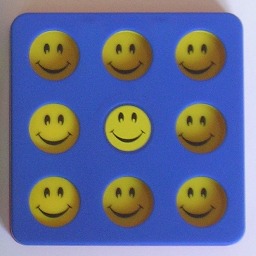


Bognar's Brainteaser is a puzzle with a frame that has a 3×3 grid of holes (with the centre hole filled),
and consisting of two layers. The layers can rotate around the central filled hole. Inside the holes are pieces
which can move from one layer to another when the layers are lined up. In each layer, two of the holes (one edge
and one corner hole) are a little bit too small to contain a piece.
The version I have has smiley's on both sides of each piece, and in the centre of each layer. The aim is
to get 9 smileys, all in the same orientation, showing on both sides. There is another version as well which
is supplied with various patterns that you have to try to attain.
This puzzle was invented by Jozsef Bognar, who also invented the Bolygok puzzle.
First we need to find out the number of configurations of the pieces and spaces, i.e.
the number of positions if all pieces were indistinguishable. Lets first look only at
the corners. Each layer has one blocked corner location, so there is one layer orientation
where the two blocked locations line up. In that case all three other corner holes have
two fillable locations. There are two spaces and four pieces in these three double locations,
and there are 3+3=6 ways to arrange them (one double location empty, or two half-empty). In
the other three layer orientations there are two double locations, and two singles. These can
be filled with 4 pieces and 2 spaces in 8 ways (spaces separated in 6 ways, or together in 2 ways).
The same numbers occur with the edge locations. Now just multiply the number of edge configurations
by the number of corner configurations for each of the four layer orientations, and add them together
to get 8*8 + 8*8 + 8*6 + 6*8 = 224 configurations. In each of those configurations the four edge
pieces can be permuted in 4! ways, as can the four corner pieces, giving a total of
224·4!2 = 129,024 positions.
If you only use gravity to move the pieces from one layer to the other, then it makes sense to
consider it a different position if you turn over the puzzle. In that case you would have
448·4!2 = 258,048 positions, two of which are solutions. It should be noted
however that while all of those positions are solvable with gravity only, they are not all
reachable from the start position with gravity only. It turns out that only 29+29+31+31 = 120
configurations are reachable instead of 224. This gives 120·4!2 = 69,120 reachable
positions, or 138,240 if you consider the flipped positions different.
I have calculated how many moves each position of Bognar's Brainteaser needs to
solve, as shown in the table below. The first two columns were calculated with the
assumption that only gravity is used to move a pieces from one layer to another,
and that not only is every quarter turn of a layer one move, so is flipping over the
puzzle. There are two solved positions because at the start, either layer can be on top.
One column shows how many moves it takes to reach the solved position, the other shows
how many moves it takes to generate a position from either one of the start positions.
The last column gives the results when pieces are freely pushed from one layer
to another. In this case flips are not necessary, so only layer quarter turns
count.
| Moves | Gravity Only Solving | Gravity Only Generating | With fingers |
|---|---|---|---|
| 0 | 2 | 2 | 1 |
| 1 | 20 | 4 | 32 |
| 2 | 54 | 6 | 167 |
| 3 | 76 | 10 | 1,496 |
| 4 | 178 | 28 | 7,124 |
| 5 | 350 | 52 | 21,996 |
| 6 | 630 | 96 | 47,887 |
| 7 | 1,212 | 178 | 40,852 |
| 8 | 2,126 | 350 | 9,333 |
| 9 | 4,060 | 666 | 136 |
| 10 | 7,372 | 1,200 | |
| 11 | 12,778 | 2,196 | |
| 12 | 21,430 | 3,916 | |
| 13 | 33,624 | 6,736 | |
| 14 | 47,134 | 10,992 | |
| 15 | 54,242 | 16,344 | |
| 16 | 44,944 | 21,396 | |
| 17 | 22,146 | 23,206 | |
| 18 | 5,226 | 20,536 | |
| 19 | 440 | 15,036 | |
| 20 | 4 | 9,332 | |
| 21 | 4,452 | ||
| 22 | 1,306 | ||
| 23 | 184 | ||
| 24 | 16 | ||
| Total | 258,048 | 138,240 | 129,024 |
| Avg Depth | 14.140 | 16.540 | 6.1423 |
Let a clockwise quarter turn of the top layer be denoted R, and an anti-clockwise turn L. Flipping over the puzzle will be denoted by a slash /.
Solving the puzzle using your fingers to push the pieces between the layers is relatively easy, but hard to describe, so I will not describe the steps in much detail.